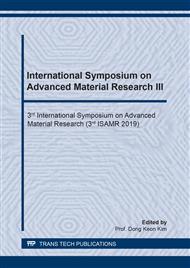p.77
p.83
p.88
p.93
p.99
p.107
p.112
p.118
p.124
Preparation and Characterization of Monodisperse Mesoporous SiO2 Microspheres Modified by Octaphenylpolyoxyethyiene
Abstract:
Monodisperse mesoporous SiO2 microsphere is a potential fine candidate carrier of dry powder inhalation, but large numbers of active surface hydrophilic hydroxyls enhance surface energy, hydrogen bonding and electrostatic force, environmental water adsorption and particle agglomeration. Conventional hydrophobic modification of surface hydroxyls, which is conducive to solve the above-mentioned disadvantages, will limit the loading of water-soluble drugs and the drug dissolution in water simultaneously. In this study, monodisperse mesoporous SiO2 microspheres were prepared as carrier and modified innovatively by amphiphilic modifier octaphenylpolyoxyethyiene and 3-aminopropyltriethoxysilane, particle diameter about 60 nm, mean pore size 21.4 nm, specific pore volume 0.95 cm3/g, and specific surface area 130 m2/g. Model drug pentoxyverine citrate was loaded by pressure infiltration and spray drying process, drug loading 8.24%, repose angle 34°, mass median aerodynamic diameter 1.03 μm, and more than 90% of drug could dissolve within 30 min both in water and organic solvents.
Info:
Periodical:
Pages:
99-104
Citation:
Online since:
April 2020
Authors:
Price:
Сopyright:
© 2020 Trans Tech Publications Ltd. All Rights Reserved
Share:
Citation:


